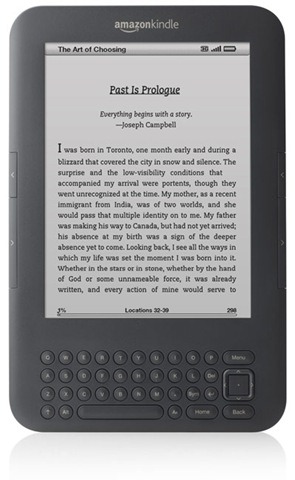 CNet’s David Carnoy has an article and poll pertaining to the thorny issue of Amazon’s Kindle page (or, rather, location) numbering scheme. Carnoy looks at the controversy as expressed in a number of Amazon discussion forum threads—some find, as Amazon notes, that it makes a good alternative to page numbers that will have to be recalculated every time orientation or font is changed. Others are less sanguine about it, and as Sayre’s Law would predict, emotions run quite high over a largely trivial issue.
CNet’s David Carnoy has an article and poll pertaining to the thorny issue of Amazon’s Kindle page (or, rather, location) numbering scheme. Carnoy looks at the controversy as expressed in a number of Amazon discussion forum threads—some find, as Amazon notes, that it makes a good alternative to page numbers that will have to be recalculated every time orientation or font is changed. Others are less sanguine about it, and as Sayre’s Law would predict, emotions run quite high over a largely trivial issue.
"Keep in mind that his [Bezos’] background is engineering and computer science, so more than likely he signed off on this whole ‘locations’ idea as it would seem quite logical to someone with an engineering background," Ron Jaffe posted on January 28. "Indications from the media are that Jeff really is concerned about the ‘customer experience,’ so perhaps he’s just not aware of the mass discontent…no, HATRED that exists for the ‘locations’ way of handling pages."
“Hatred”? Really?
The most important argument against it seems to deal with academic citations (which would also be in keeping with Sayre’s Law, as originally formulated). Some people are concerned over whether academic institutions will be willing to accept that form of citation. A counter-suggestion is just picking a standard medium size font and setting page numbers based on that—but Carnoy fails to point out that this falls down in that not everyone is going to be using a Kindle. “Pages” on the Kindle app on my iPod Touch would be numbered considerably differently than on a Kindle reader, and both would be numbered differently than in the Kindle app on my iPad. But a given location number will apply to any of them.
Of course, part of the problem is the very fuzziness of those numbers. My Kindle might show me locations 20-25 of a book, while my iPod Touch might only show me 21-22. So it might be a little tricky to find the exact location of a given quote when cited that way—it could be on one of two or more screens, depending on the reader size. But then, even a single page number can encompass several paragraphs or more of text, and citations can be split across multiple page numbers too.
But I think some of the fuss is overwrought. The academic community tends to be at least a bit flexible in terms of citations. As I pointed out a couple of months ago, citation methods exist for e-books now, independent of page number. They also exist for things like world wide web pages, which didn’t exist at all just over twenty years ago, and also don’t have page numbers. I have little doubt that the academic community will adapt to location numbers just fine.
The CNet article also includes a reader poll on opinions for, against, and apathetic to the Kindle’s location numbering scheme. At the time of this article’s writing, it has received 648 votes and is currently running neck and neck for and against the scheme—each has 42% of the vote.

































Count me as one who is “passionate” about the lack of page numbers on Kindle.
In the vast majority of cases, the Kindle “edition” of a book is textually identical to a paper edition. What purpose is served by making it impossible to cross-reference the paper and Kindle editions? I can think of no motive other than pure spite.
I don’t care whether Kindle uses “locations” or not. All I care about is that it also make available the page numbers. Google Books manages it: apparently Nook manages is. Why is it only Kindle that cannot?
I once downloaded a Kindle book that even included the index, from the paper edition! Of course, it was completely useless without access to page numbers.
This one issue, on its own, was enough for me to abandon Kindle for Google eBooks.
As an academic who not only uses footnotes but grades college theses and reviews professional articles, this citation issue is overblown. We already have ways of citing web pages, and e-books are really not so different. The purpose of citations is to allow a reader to seek more information from a source or to verify it. It wouldn’t take that much more work to find the right passage with the Search function on a Kindle if one were to go to all the trouble to double-check citations.
Having thought about this some more, I’ve realized the reason I feel so strongly about this issue. It’s that Amazon’s position is so gratuitous.
It would cost Amazon and publishers very little to add markers corresponding to page boundaries to future Kindle editions. Locations could continue to be the primary way of dividing up books, but pages could be an extra option. This would satisfy my needs, and probably those of most of us who are complaining.
Instead, Amazon refuses to make any changes.
I can think of only two reasons for this. Either Amazon is pig-headedly refusing to admit that it made a mistake in its initial design. Or there is some Machiavellian scheme to dominate the e-book market by making Amazon’s location scheme the standard. Are locations patented? After all, Amazon did come up with the notorious “one-click” patent.
I personally think some users are definitely stuck in the old ways. Most of us Kindle users are perfectly happy without “page numbers”. You do know that each edition of a dtb could possibly have different page numbers, don’t you?
I see this affecting <.1% of all eBook readers.
Odd – I would have thought the one standard thing in an ebook would be number of words. Wouldn’t is be simplest to cite: “word 34324 to 34348”?
I format ebooks for authors and publishers and offer a page number grid as one of my services. The page number grid goes right after the table of contents and links to the corresponding page numbers from the print edition of the book. This allows ebook users to easily “turn” to the same page as those using the print edition. Here is the link to a book I recently formatted, and you can download the free sample to see how it works: Still Hurting? Find Health!
I find it hard to believe that anyone making a stink about this isn’t either (a) joking or (b) unfamiliar with e-books. The “page numbers” given by other e-book readers and applications are no more or less significant than the Kindle’s location numbers, as they don’t necessarily corrrespond to page numbers in printed editions. Of course academic institutions will accept Kindle location numbers in bibliographies, etc. Many millions of people are already using Kindles and Kindle apps, and the location numbers provide an easy way of specifying where quotations come from. Different printed editions of the same book often don’t have the same number of pages; why would e-books be any different? Similarly, if I cite a page number from a book, I don’t have to make sure it’s from an edition that you can still get your hands on. Is today April Fool’s Day or something?
@Michael:
Some may be “stuck in the old ways”, but that’s not my objection. If there are any books that are published ONLY in Kindle editions, then they can dispense with page numbers as far as I am concerned.
However, when books are available in paper format, and/or ebook formats other than Kindle, then page numbering provides a way for reader of different editions to be able to reference the same passage. This is impossible if the Kindle-specific “locations” are all that is available.
You say that “[t]he purpose of citations is to allow a reader to seek more information from a source or to verify it”. However, if a “location” is all that is given, then the ONLY way to verify a citation is by purchasing the Kindle edition (and swelling Amazon’s coffers). As an academic, what would you do if you wanted to verify a citation to a Kindle location, but your university library contained only a paper copy, or an e-book in a non-Kindle format?
It’s true that page numbers can differ between editions, but generally not by much. In my experience. it’s not that difficult to find a passage based on a page reference to a different paper edition: one can usually pin it down to a 10 or 20 page range at the worst. By contrast, I have found it almost impossible to guess a page range based on a Kindle location.
In effect, page numbers function as an open standard for book citations. Kindle locations, on the other hand, seem like a Microsoft-style attempt to impose a proprietary technology on academic research.
@Dan:
The “page numbers” given by other e-book readers and applications are no more or less significant than the Kindle’s location numbers, as they don’t necessarily corrrespond to page numbers in printed editions.
Not true, at least of Google eBooks which provide an option to view the printed edition as a PDF.
One good thing about locations versus word count is you can include the cover, front matter, and anything at the back of the book as well.
Also: if you need to know the precise location of a sentence for citation purposes, highlight it, then check your notes–the location number will be appended there.
I actually think locations make more sense, and are more useful, than nearly any other method I’ve seen so far for numbering an ebook, but I do wish Amazon would open up about exactly how many characters/spaces/bytes/gremlins/whatever make up a single unit of “location.”
@Chris Walters:
Do you know whether Google eBooks, Apple iBooks, Nook, Sony, etc. are allowed to include Kindle location references? Does Amazon have some kind of intelelctual property rights over them?
Do you think that Amazon is attempting to lock in its current advantageous position in the eBook market by making its location scheme the standard?
@Howard: I see this affecting <.1% of all eBook readers.
The poll at the CNET article linked to in the main postcsurrently shows 42% wanting Amazon to include page numbers n (versus 41% who are fine with the current setup). Not a scientific poll, or course, but it does suggest that the number is rather greater than you suggest.
When I looked at the poll again, it’s back to 42% and 42% (with 17% apathetic—clearly, there’s some rounding going on here). But even if one of them pulls ahead to 43% or drops back to 41%, that’s still well within potential margin of error for such a poll. It seems that, at least in CNet’s self-selecting audience, pro- and anti-Kindle numbering partisans are essentially neck and neck. There may be a bunch of people who want page numbers, but just as many are fine with them how they are.
And in regard to the “but you’d have to buy a Kindle” argument, I submit that Kindle location numbers are not any less useful than page numbers for a hardcover edition when all you have is the paperback, or vice versa. For instance, Anne McCaffrey’s Dragonrider’s Guide to Pern used page numbers from the paperback editions as references—which wasn’t that helpful to me, since all I had were the book club omnibus editions!
Maybe we should lobby print publishers to start including location numbers on the corners of their pages. 🙂
@dw “If there are any books that are published ONLY in Kindle editions, then they can dispense with page numbers as far as I am concerned.”
This really is missing the point. If a publisher releases a title as e-only, then they don’t ‘dispense’ with pages… there were never any pages to begin with, ergo none to ‘dispense’! And it’s often assumed that every ebook has a layout (PDF) format as well as an xml (Kindle, epub, mobipocket) format. That’s not the case.
It’s clear the location-based system is not popular with you, which is understandable. But I would question your assumption that this is part of a monopoly play by Amazon. They have far greater leverage in areas such as pricing (not every publisher has gone Agency!), catalogue, market status, and integration with the ecommerce. I suspect the blog author’s assumption is more likely: that this simply appeared to those signing off as the most rational proposition. A case of Occam’s Razor in this instance.
Having worked in academic publishing for over 20 years, I can hand on heart say there are far better ways of referencing material in ebooks than using the page number: DOIs being one of many examples. Academia seems to be working fine with them to boot!
Why would you expect a digital copy to preserve the page numbers of a hard copy? If you read a newspaper article online, do you expect it to show the page and section of the print version? If you download a 10 page journal article from an online database, do you expect it to display the page numbers from the hard copy version? It’s been a while since I did any academic research, but I don’t remember the online databases displaying page numbers, which is why you cited it as coming from an online database along with the day it was retrieved.
Even if kindle editions had a page numbering system, that wouldn’t mean you’d be able to cross reference it with a paper copy. You can’t do that with epub books either, the page numbering does not match the paper version. For example, one of my epub books has 325 pages, the hardback has 384 pages, and the paperback 464. So even if you could cross-reference, how would you know what paper version to cross reference to? And the page numbering in an epub from B&N might not match the page numbering of an epub from Sony as the two might have been converted from different source files (pdb vs. lrf).
And one very good reason for locations is that it makes it easier to sync reading location across devices. Yes, you can do that with epub page numbers, but it’s much less precise than the locations on the kindle apps. I have ebooks in both formats, and with epubs finding your reading location by page number can mean 4 or 5 page swipes on your mobile device before you locate your spot. The kindle locations eliminate that problem.
IF this is a problem then it’s for the most part an ebook problem in general, NOT an Amazon problem. Sure Sony uses “page numbers”, but they’re meaningless and change when you change text size (not sure how Nook does it), ADE’s page numbers don’t appear to correspond to anything either. At least locations are applicable across type sizes and devices (PC/Mac, Kindle, Android, iThingy, etc).
The only exception at this time appears to be Google where you can switch to viewing the actual book page scans if using their apps.
dw – I believe it only ‘affects’ a teeny tiny number of people. Your reference to the survey concerns a ‘desire’ for page numbering, though I could not find the survey details you refer to.
When people are asked would they like something – they almost always say yes to an extent enormously higher than they actually need something.
I agree with those that believe it to be an irrelevance. Academia needs to adapt. Word numbering looks like a nice idea.
It seems obvious from the number of postings that this isn’t a minor issue, and for good reason. New technologies almost always create a need for new standards. Some highways systems drive on the right, some on the left. After almost two centuries, railroads still don’t have a standard gauge, although most of the current differences are practical (i.e. narrow gauges for mountains). Even a new technology like cellular phones has competing standards. An AT&T iPhone can run on T-Mobile’s networks in the U.S., but Apple needed to create a new phone for Verizon.
And establishing standards is messy. Standards mean winners and losers. If my standard is adopted, I win and you lose. Standards are also heavily political (in the broad, emotional sense). Should ebooks genuflect to print and include page tags? Should ebooks win and something like Amazon’s location markers be included, perhaps in small, grey type in the margins of printed books? Who will win? And who will decide who wins? We don’t live in a dictatorship and, if we did, the dictate would probably be a bad choice.
We also shouldn’t forget that this problem has always been with us. It is as common as multiple editions of titles and it’s why first Jews and later Christians applied verse numbering to the Bible. The need for locating text even applies to modern fiction.
I wrote the only book-length, day-by-day chronology of Tolkien’s The Lord of the Rings. In it, each event is linked not only to the day it happened, but to every place in LOTR where that event is mentioned. Unfortunately, there was no way I could resolve my links down closer than the book and chapter, even though a chapter may cover several days and the change of day references Tolkien made may be hard to locate.
Yes, I could have included page numbers in the side notes. That would be easy. I’ve got a much-marked, one-volume edition of LOTR tagged with dating added. But that numbering would only apply to that edition. Readers with other editions would be out of luck.
I thought about counting how many pages into a chapter an event occurs, but that would vary between editions and would mean a lot of messy page counting by readers. In the end, I stuck with book/chapter references and toyed with the idea of encouraging Tolkien’s publishers to number the paragraphs in each chapter in the side margin. Then I could use a book-chapter-paragraph reference system, which should be more than enough for readers. But I’m not Christopher Tolkien. I can’t make publishers adopt that scheme or any other.
I’d add that some of this fuss over pagination is an effect of a frustration that I suspect many people feel when reading on a Kindle. We are left floating in a digital ga-ga land. There’s no obvious physical clue as to how far along we are in a book or how far we need to read to stop at a chapter break. The little dots at the bottom of a page (light and dark) help, but they’re abstract. Instapaper ereaders help a bit by making the length of the dots correspond to the length of an article, but that’s much harder to do with books that can vary (in print) from 20 to 2,000 pages.
I suspect we’ll be fussing over this for quite a while and I doubt technological change will force a standard on us like evolving systems are moving almost all cellular systems toward LTE.
–Michael W. Perry, author of Untangling Tolkien
I’d add that Amazon and other ereader makers could create a scheme that’d give users a visual representation of where they are in a book. One possibility would be a bit like the pages window for InDesign. It would use page-like icons, with rows of icons representing chapters and all the chapters lined up on top of one another. The reader’s current page would be highlighted. Readers could glance at that and say, “OK, I’ve got three more pages before I finish this chapter and I’m about one-third the way through the book. Now I know where I am.”
The rub might come with what constitutes a page in that representation? Would it be a page in that ereader with its current font settings? That might change so much from book to book, readers would get confused. Would it have behind it some mythical standard book? Then we’d need a standard book. With a bit of effort, the etext could even be tagged so that page display shows where the reader would be were they reading a standard printed version, say the first hardback edition. That’d satisfy the more serious uses for references. Anyone who wanted to know the printed versions page number could find it there.
I don’t know, but I do wish Amazon would release how their location numbering scheme works so it could be copied. I’ve toyed with the idea of creating a Kindle edition of Untangling Tolkien that’d include Kindle location references. It’d help if those same references were being used in other ebook readers as a sort of de facto standard.
After all, some standards happen because everyone copies what the market leader is doing.
I can understand the perceived need for page numbers for those in a book club or a class, but not for general fiction readers. The line of dots in the book list show me approximately how long a book is and the progress dots and percentage when I’m in a book show me how far along I am and how much I have left to read. Personally, I don’t need to know how many “pages” that represents.
Others posting here are correct that there have always been page number differences between different editions of a physical book, why the outcry over ebooks and locations?
I think it’s because people are still trying to equate an ebook with a physical book and it’s just a different beast. brooksse has is right, why would we expect it to be the same when we don’t with other differing formats of the same article?
I don’t think this was some nefarious scheme by Amazon either. It was just a logical solution to a technical problem.
I could understand including a reference that indicates the page number of a printed book in a digital one.
If there is a printed version. If it’s by the same publisher. (Why would a publisher use a competitor’s reference numbers.) Only to reference the hardcover, of course; that’s definitive. Unless it was only released in paperback and ebook.
The real issue is: who’s going to do the cross-referencing? Who’s going to check which chapter & which paragraph starts at what page of the physical book, and enter that data in the ebook somehow? (Nevermind how the Kindle would display such info, or how epubs would do so… presumably, the ebook-reading software could allow this.)
And is that data-mining supposed to be free, or will people be happy to pay an extra couple of dollars for the “paper-number-compliant” ebook version?
Changing from locations to word count would make big numbers even bigger. If locations are 128-byte blocks, and the average word is six letters long, over twenty times larger. That’s not going to make the numbers any easier to use, or any more like theoretical page numbers. But then I’m of the “it’s quite a long book, but I’m 80% through it” school, and don’t need much precision.
(And count me as a non-fan of the ReCaptcha, which I didn’t even know was there until I was told I’d failed it, requiring me to open the page in a different browser, one where I don’t have blocking on by default in. Also not a fan of the annoying popup toolbar at bottom, which, again, my normal browser had shielded me from.)
@ Michael W. Perry:
Have you seen what the people at Intuity are doing in this space? They’re just experiments at this stage, and I think they just work on iPad for now, but there’s some really cool thoughts about how to give useful feedback to the reader in a way that can also add to the total experience for the reader. The post has video clips so people without iPad access can see how each effect works.
http://blog.intuitymedialab.eu/2010/12/22/ux-lab-how-can-we-enrich-the-reading-experience-on-a-screen/
@Elfwreck:
The real issue is: who’s going to do the cross-referencing? Who’s going to check which chapter & which paragraph starts at what page of the physical book, and enter that data in the ebook somehow?
Ummmm — the publisher. You know, the organization that owns the text, that put the text into digital form in the first place and that published the printed edition?
(Nevermind how the Kindle would display such info, or how epubs would do so… presumably, the ebook-reading software could allow this.)
The Kindle already has the ability for the user to add notes at any location the text. The page breaks could just be like prepared notes. Or the Kindle could copy the way any of the other e-book readers indicate this information.
And is that data-mining supposed to be free.
Yes. It is already effectively free in other e-book formats. There would be a small transition cost of adding page breaks to the format supplied to Amazon by publishers and the marginal cost would be zero.
There have always been page number differences between different editions of a physical book, why the outcry over ebooks and locations?
First, the vast majority of books ever published exist only in one edition. The number of books that have been republished in a huge variety of editions is very small.
Second, it has not generally been practical for different editions of printed books to give the data necessary to cross-reference the same passage. This has only been done for texts considered especially important, such as the Bible or other sacred texts. However, this rationale does not apply to e-readers, whose extra possibilities make it perfectly practical to indicate the page number of the corresponding print edition, as Google has shown.
I would certainly be in favor of adding other data such as word count to ebooks. That could only improve the ability to cross-reference different editions of the same text. The fact that Amazon’s locations seem to be calculated in some kind of opaque and proprietary manner constitutes another objection to them. If in future we hope to see robust competition in the e-book market then we should also wish for free and open standards in pagination/locations.
Want to know the approximate page equivalent to a given location? Here, knock yourself out: http://www.bookmonk.com/labs/numbers.php Happy now?
@ DW: “Page numbers” are free in other ebook readers. “Page numbers that correspond to a printed book version” are not, except in PDFs, which tend to look awful on tiny screens.
And adding page *breaks* that match the printed version would be ridiculous. I don’t want my ebook reading to stop every screen-and-a-half to force me to read with the page breaks that paper has.
Want page numbers? Stick to PDFs. The book you want isn’t available as a PDF? Complain to the publisher. A lot of us have to cope with books we want not being available in our format of choice.
The number of books that have been republished in a huge variety of editions is very small.
Except for public domain works, which tend to have several versions, and popular fiction, which tends to have a hardcover & paperback edition.
The Nook Color uses an interesting scheme. They DO show page numbers (upper right hand corner with the designation 25 of 392, for instance). The manual explains that while the page number is accurate (I assume with the hard cover), it may take several screenfuls to get through a page. I have been using a Kindle for so long that I actually find the page numbers distracting since I have come to prefer percentage. But then I am not doing academic citing. The Nook’s solution would be easier for academics and for those reading the same book with others who are reading it in hard cover.
Legal publishers have been using numbered paragraphs for decades now. All you need is one extra option in your e-reader — ‘Show/Hide paragraph numbers’ — and all your referencing problems are solved. Easy!
Amazon has now added this feature:
http://newteleread.com/wordpress/paul-biba/new-features-coming-to-kindle-3-real-page-numbers-public-notes-and-more/#comment-1200550
Someone write that page nubersaren’t so important when reading fiction. That may or may not be true. However they are essential when reading text books, and not so much necessarily for citations or cross-referencing or verification.
Can someone out there tell me how to use the INDEX of a kindle version of a legal text ebook I just bought. There’s the subject index and I can’t use it. This means one of to things….either i shall not be buying legal text books (or other text books for that matter) for my kindle and will only use it for leisure, or else Amazon solves this issue. The question of edition and publisher doesn’t come into the equation. The kindle version that is published with page numbers will be the same as the edition and publsher that it is taken from as advertised! Easy-peasy.